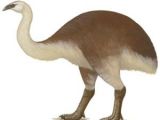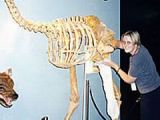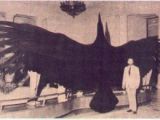Birds can be measured by employing three factors: weight, height and wingspan.
The current largest bird is the African ostrich (Struthio camelus): the bird can reach 160 kg in weight and 2.75 m height. But some wrongly called prehistoric birds were even bigger.
One thousand years ago, the Maori people of New Zealand hunted to extermination the giant moa (Dinornis robustus) (image 2), which could have reached 3 m height and 250 kg of weight. In Madagascar, the elephant birds (Aepyornis maximus) (image 1), hunted to the extinction 500 years ago, were even bigger: 3.3 m height and 500 kg. Both moas and elephant birds were relatives of the ostrich.
60 to 30 million years ago, in Europe and North America there lived the Gastornis (Diatryma), two meters high flightless birds, which could have been related to ... the ducks. Also very large were the terror birds from South America (which later entered North America). These birds reached 2.8 m height, 400 kg and were ferocious predators.
You can imagine their killing abilities, adding to that the fact that they must have possessed the largest bird skull with impressive sharp pointed beaks: one recently dug terror bird skull was as big as a horse one (photo 4). Terror birds still have current relatives in tropical South America: the seriema birds. They must have been eliminated by highly evolved carnivores that entered South America 2 million years ago.
Eight to one million years ago, thunder birds (Dromornis stiltoni) inhabited Australia. These birds reached 3 m height and ... 680 kg (1,500 pounds), being heavier built than the previous ones (photo 3) and than a cow. The skull was 46 cm (18 in) long. Bullockornis, a smaller relative, lived 4 million years ago
Scientists still do not know if they were herbivorous or carnivorous, but they were related to ... geese and ducks! Many think they were exterminated by the first Aborigines.
All these birds were flightless, and grew so big only after the dinosaur extinction. But the largest flying bird ever discovered was the Argentavis magnificens (photo 5), which lived 16-23 million years ago in South America.
They had a wingspan of 6.3 m (28 feet), almost as big as flying pterosaurs that lived during the dinosaur era and reached wingspans of up to 12 m. These birds were relatives of the condors and storks and more likely had a similar way of life to vultures and condors. The bird was 3.5 m long and weighed till 100 kg.
Today, the largest wingspan (3.5 m) belongs to the wandering albatross (Diomedea exulans) (a record measured 3.7 m), a sea bird weighing 12 kg as adult (but pre-adult albatrosses can weigh as much as 16 kg). In land, the largest wingspan belongs to the Andean condor (Vultur gryphus): 3,15 m.
The males can be as heavy as 15 kg. All these birds (Argentavis and both living ones) employ or employed soaring flight, that's why they developed such large wingspans. The condor and Argentavis use (used) thermal currents in land, like vultures and storks do, while the albatrosses soar over the winds generated by sea currents.
But the heaviest current flying bird is the African Kori Bustard, whose male can have weights of over 20 kg (50 pounds), but also males of the Great Bustard from Europe and Asia can reach 21 kg, with a wingspan of 240 cm and a height of 1.1 m. They employ mostly active flight, but fly rarely.
The Sarus crane (Grus antigone) from Southern Asia is the highest flying bird (over 1.8 m or 6 feet tall), but this is due to the extremely long feet. It has a 2.4 m wingspan.
These are the largest birds, but which is the smallest species? It is found in Jamaica and Haiti islands, and it is, of course, a species of hummingbirds: Mellisuga minima, 6 cm (2.3 inch) long and weighing 2g.

 14 DAY TRIAL //
14 DAY TRIAL // 



